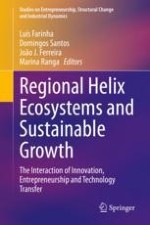2020 | Buch
Regional Helix Ecosystems and Sustainable Growth
The Interaction of Innovation, Entrepreneurship and Technology Transfer
herausgegeben von: Ph.D. Luís Farinha, Prof. Dr. Domingos Santos, João J. Ferreira, Ph.D. Marina Ranga
Verlag: Springer International Publishing
Buchreihe : Studies on Entrepreneurship, Structural Change and Industrial Dynamics
